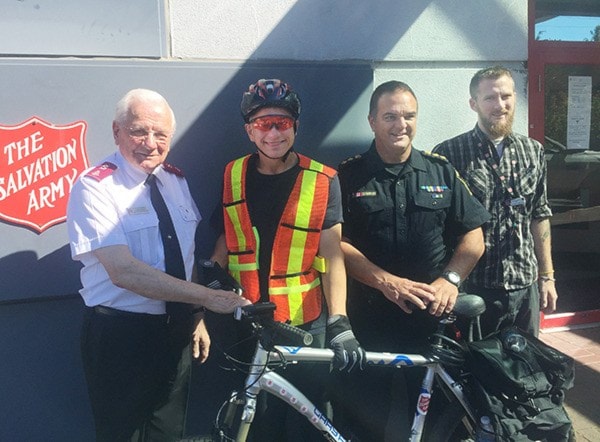Salvation Army outreach workers are now hitting the city on two wheels thanks to a donation from the Abbotsford Police Department.
In the past, the Sally Ann’s two full-time and one part-time outreach workers have relied almost exclusively on a van. But the donated bicycle – which had been destined for a police auction – is now being used by workers to access harder-to-reach locations, such as camps in forests and other areas inaccessible by a van.
The bikes also give workers more visibility and allow for easier access along busier roadways and for people on the move, according to Nate McCready, the Salvation Army’s community ministries director.
“With the bike, you see somebody and pull over and start chatting,” he said.
The bicycle outreach program started on Aug. 23, and it’s not the only new service being offered by the organization.
The Salvation Army’s new medical clinic for marginalized clients got a further boost this month with the addition of a doctor who can see patients for half a day each week.
A licenced practical nurse and a nurse practitioner had been offering services at the clinic. But earlier this year, Haitham Kharrat, a medical resident completing his training in Abbotsford stopped by the clinic to see how the nurse practitioner was helping the community.
Now fully certified, Kharrat – who won a UBC award for a research and advocacy project on such a clinic – is now practising in Abbotsford and treating patients at the Salvation Army. Fraser Health is providing financing for both the nurse practitioner and doctor services at the clinic.
McCready notes that the clinic provides a vital service to a population that rarely sees a doctor and yet is susceptible to a variety of health issues. It gives them an option other than turning to the hospital’s emergency room or the city’s busy walk-in clinics.
The Salvation Army also now has naloxone – an antidote to opioid overdose – on site. Workers have administered it five times so far, including three times across the street. The organization is also working on obtaining the training necessary to be able to distribute and train others in the use of naloxone. Earlier this year, Health Canada allowed naloxone to be distributed over-the-counter as the country deals with an increasing amount of deaths from opioid use.
By the end of July, 21 people had suffered fatal overdoses in Abbotsford.
“We’re hearing [there is] more use of naloxone because of that,” McCready said.
This fall, McCready himself is moving on from his spot leading Abbotsford’s Salvation Army services. McCready is heading to Vancouver, where he will serve as divisional emergency shelter co-ordinator and try to implement lessons learned from his time in Abbotsford.
The Salvation Army recently announced that all of its shelters would be “low-barrier” and McCready, who oversaw the Abbotsford shelter’s conversion to a low-barrier facility, will lead the drive in British Columbia.
A local replacement has not yet been hired.
